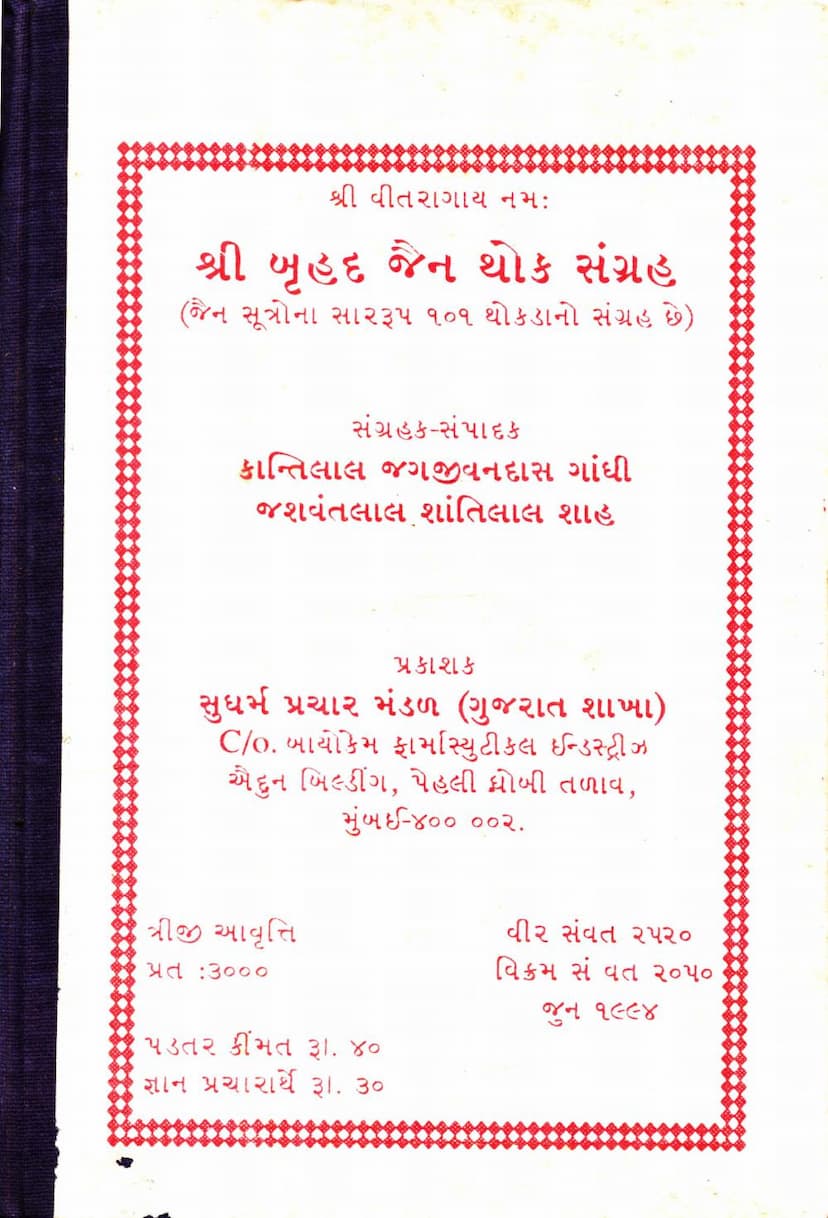Bruhad Jain Thoak Sangraha
Added to library: September 1, 2025

Summary
This document is a detailed summary and translation of the Jain text "Bruhad Jain Thoak Sangraha" (Great Collection of Jain Principles). Here's a comprehensive summary in English:
Book Title: Bruhad Jain Thoak Sangraha (બૃહદ જૈન થોક સંગ્રહ) Meaning: Great Collection of Jain Principles/Topics Author(s)/Compiler(s): Kantilal Jagjivandas Shah, Jashwantlal Shantilal Shah Publisher: Sudharm Prachar Mandal (Gujarat Branch) Publication Date: Third Edition, June 1994 (Veer Samvat 2520 / Vikram Samvat 2050) Content: The book is a compilation of 101 "Thoakda" (brief explanations or points) derived from Jain scriptures. It aims to provide a concise yet comprehensive overview of key Jain concepts.
Overall Purpose and Scope:
The "Bruhad Jain Thoak Sangraha" serves as a foundational text for Jain followers, particularly lay practitioners (Shravakas). It distills essential Jain philosophy and practices from various scriptures into 101 digestible points. The content covers a wide range of topics, from fundamental metaphysical principles to practical daily conduct and spiritual progression.
Key Sections and Concepts Summarized:
The document highlights the book's comprehensive nature by outlining its extensive table of contents. While a detailed summary of all 101 points is beyond the scope of a concise overview, the provided text strongly emphasizes the following major themes and sections:
-
Nav Tattva (Nine Truths): The text begins by elaborating on the nine fundamental truths of Jainism:
- Jiva Tattva (Soul)
- Ajiva Tattva (Non-soul)
- Puṇya Tattva (Merit/Virtue)
- Pāpa Tattva (Demerit/Sin)
- Āshrava Tattva (Influx of Karma)
- Saṃvara Tattva (Stoppage of Karma)
- Nirjarā Tattva (Shedding of Karma)
- Bandha Tattva (Bondage of Karma)
- Moksha Tattva (Liberation) It explains each Tattva from both the practical (Vyavahar Naya) and ultimate (Nishchaya Naya) perspectives, detailing their nature, essence, and the categories of beings related to them (e.g., various classifications of Jivas, the properties of Ajiva, the fruits of Puny and Pāp, the means of Āshrava and Saṃvara, the process of Nirjarā, the nature of Bandha, and the ultimate goal of Moksha).
-
Panch Indriya (Five Senses): The text details the five senses (Shravan, Chakshu, Ghran, Ras, Sparsh) and their respective objects (sound, form, smell, taste, touch), including the nuances of their scope and functioning.
-
Six Kaya (Six Types of Living Beings): A significant portion is dedicated to explaining the six categories of life forms, emphasizing the principle of Ahimsa (non-violence) towards all of them:
- Prithvi Kaya (Earth bodies)
- Ap Kaya (Water bodies)
- Teu Kaya (Fire bodies)
- Vayu Kaya (Air bodies)
- Vanaspati Kaya (Plant bodies - further divided into Pratyek and Sadharan)
- Trasa Kaya (Mobile beings - Jivas with two or more senses) The text elaborates on the characteristics, classifications (like subtle vs. gross), lifespans, and the immense number of lives within each category, underscoring the importance of careful conduct.
-
Eight Karmas: A detailed breakdown of the eight types of karma is provided, explaining their nature, the causes for their bondage, the ways they manifest as experiences (bhoga), their duration (sthiti), and the impediments (abadha) they create. The text categorizes these karmas:
- Jnanavaraniya (Knowledge-obscuring)
- Darshanavaraniya (Perception-obscuring)
- Vedaniya (Feeling)
- Mohaniya (Delusion)
- Ayushya (Lifespan)
- Nama (Name/Body-form)
- Gotra (Status/Class)
- Antaraya (Obstruction) The text highlights Mohaniya Karma as the "king" of karmas due to its pervasive influence on spiritual progress.
-
Chowbees Dandak (Twenty-four Categories): This section is exceptionally detailed, covering various classifications of beings based on their sensory organs, the body types they possess, the stages of their spiritual development (Guna Sthanak), their modes of conduct (Yoga), experiences (Vedana), inclinations (Leshya), and their journey through different realms of existence (Gati). This part acts as a comprehensive classification of the types of beings and their attributes within the Jain cosmos.
-
Gun Sthanak (Stages of Spiritual Development): The text meticulously explains the 14 progressive stages of spiritual evolution for a soul, from the lowest state of delusion (Mithyatva) to the highest state of omniscience and liberation (Siddha). Each stage is described by its characteristics (Lakshan), associated karmas, the types of vows observed (Samayika, Chedosthapaniya, etc.), and the specific karmic obstructions or purifications present.
-
Other Key Concepts: The book also covers:
- Panch Sharir (Five Bodies): Audarik, Vaikriya, Aharak, Taijasa, and Karmana.
- Dasha Upayog (Ten Types of Consciousness/Attention): This includes various types of knowledge (Mati, Shruta, Avadhi, Manahparyav, Keval) and ignorance (Mati, Shruta, Vibhanga).
- Four Meditations (Dhyana): Artadhyana (sorrowful meditation), Raudradhyana (fierce meditation), Dharmadhyana (righteous meditation), and Shukladhyana (pure meditation).
- Nirgrantha (Ascetics) and their Conduct: Details the virtuous qualities and practices of Jain monks.
- Shravaka's Virtues: Outlines the twenty-one virtues or ethical guidelines for lay followers.
- Tirthankara's Qualities: Describes the thirty-four miraculous attributes of Tirthankaras.
- Celibacy (Brahmacharya): Explains its thirty-two merits and allegorical comparisons.
- Six Kōśas (Six Causes of Karma Bondage): While not explicitly enumerated in the provided text snippet, this is a fundamental concept often discussed alongside karma.
- Seventy-three Virtuous Acts (for spiritual progress): These are practices that lead to the soul's upliftment.
- Hundred and Six Faults in Food: A detailed list of dietary restrictions and considerations for monks and nuns to maintain purity and avoid karma.
- Thirty-two Ascetic Practices: Practices undertaken for shedding karma.
- Various classifications related to beings' lifespan, birth, death, and states of existence.
Structure and Style:
The "Bruhad Jain Thoak Sangraha" is organized logically, presenting complex Jain doctrines in a structured manner. The language is accessible, aiming to simplify scriptural knowledge for the common follower. The inclusion of an errata sheet ("Shuddhipatra") indicates a commitment to accuracy and refinement in subsequent editions.
Overall Significance:
This book is a valuable resource for anyone seeking to understand the core tenets of Jainism. It provides a systematic approach to learning about the soul, karma, the path to liberation, and the ethical framework for both monastic and lay life. The compilation aims to make profound spiritual knowledge accessible, fostering a deeper understanding and practice of Jain principles.